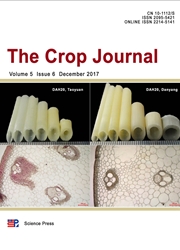

 中文摘要:
中文摘要:
Superoxide dismutase(SOD, EC 1.15.1.1) plays a key role in response to drought stress, and differences in SOD activity changes among cultivars are important under drought conditions. We obtained the full-length DNA of the chloroplast Cu/Zn-SOD gene(Ah CSD2)from 11 allotetraploid cultivars and 5 diploid wild species in peanut. BLAST search against the peanut genome showed that the Ah CSD2 genes g CSD2-1 and g CSD2-2 are located at the tops of chromosome A03(A genome) and B03(B genome), respectively, and both contain 8exons and 7 introns. Nucleotide sequence analyses indicated that g CSD2-2 sequences were identical among all the tested cultivars, while g CSD2-1 sequences showed allelic variations.The amino acid sequences deduced from g CSD2-1 and g CSD2-2 both contain a chloroplast transit peptide and are distinguished by 6 amino acid(aa) residue differences. The other 2aa residue variations in the mature peptide regions give rise to three-dimensional structure changes of the protein deduced from the genes g CSD2-1 and g CSD2-2. Sequences analyses of cultivars and wild species showed that g CSD2-2 of Arachis hypogaea and g Aip CSD2(Arachis ipaensis) are identical, and despite the abundant polymorphic loci between g CSD2-1 of A.hypogaea and sequences from A genome wild species, the deduced amino acid sequence of Ah CSD2-1(A. hypogaea) is identical to that of Adu CSD2(Arachis duranensis), whereas Aco CSD2(Arachis correntina) and Aca CSD2(Arachis cardenasii) both have 2 aa differences in the transit peptide region compared with Ah CSD2-1(A. hypogaea). Based on the Peanut Genome Project, promoter prediction revealed many stress-related cis-acting elements within the potential promoter regions(pp-A and pp-B). pp-A contains more binding sites for drought-associated transcriptional factors than pp-B. We hypothesize that the marked changes in SOD activity in different cultivars under drought stress are tightly regulated by transcription factors through transcription and expression of Ah CSD2 genes.
 英文摘要:
英文摘要:
Superoxide dismutase (SOD, EC 1.15.1.1) plays a key role in response to drought stress, and differences in SOD activity changes among cultivars are important under drought conditions. We obtained the full-length DNA of the chloroplast Cu/Zn-SOD gene (AhCSD2) from 11 allotetraploid cultivars and 5 diploid wild species in peanut. BLAST search against the peanut genome showed that the AhCSD2 genes gCSD2-1 and gCSD2-2 are located at the tops of chromosome A03 (A genome) and B03 (B genome), respectively, and both contain 8 exons and 7 introns. Nucleotide sequence analyses indicated that gCSD2-2 sequences were identical among all the tested cultivars, while gCSD2-1 sequences showed allelic variations. The amino acid sequences deduced from gCSD2-1 and gCSD2-2 both contain a chloroplast transit peptide and are distinguished by 6 amino acid (aa) residue differences. The other 2 aa residue variations in the mature peptide regions give rise to three-dimensional structure changes of the protein deduced from the genes gCSD2-1 and gCSD2-2. Sequences analyses of cultivars and wild species showed that gCSD2-2 of Arachis hypogaea and gAipCSD2 (Arachis ipaensis) are identical, and despite the abundant polymorphic loci between gCSD2-1 of A. hypogaea and sequences from A genome wild species, the deduced amino acid sequence of AhCSD2-1 (A. hypogaea) is identical to that of AduCSD2 (Arachis duranensis), whereas AcoCSD2 (Arachis correntina) and AcaCSD2 (Arachis cardenasii) both have 2 aa differences in the transit peptide region compared with AhCSD2-1 (A. hypogaea). Based on the Peanut Genome Project, promoter prediction revealed many stress-related cis-acting elements within the potential promoter regions (pp-A and pp-B). pp-A contains more binding sites for drought-associated transcriptional factors than pp-B. We hypothesize that the marked changes in SOD activity in different cultivars under drought stress are tightly regulated by transcription factors through transcription and expression of AhCSD2 genes.
 同期刊论文项目
同期刊论文项目
 同项目期刊论文
同项目期刊论文
 期刊信息
期刊信息
